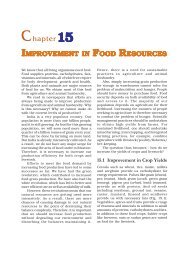C
Create successful ePaper yourself
Turn your PDF publications into a flip-book with our unique Google optimized e-Paper software.
Muscles contain special proteins called<br />
contractile proteins, which contract and relax<br />
to cause movement.<br />
Spindle shaped<br />
muscle cell<br />
Nuclei<br />
(a)<br />
(b)<br />
Nucleus<br />
Striations<br />
Striations<br />
Nuclei<br />
to bones and help in body movement. Under<br />
the microscope, these muscles show alternate<br />
light and dark bands or striations when<br />
stained appropriately. As a result, they are<br />
also called striated muscles. The cells of this<br />
tissue are long, cylindrical, unbranched and<br />
multinucleate (having many nuclei).<br />
The movement of food in the alimentary<br />
canal or the contraction and relaxation of<br />
blood vessels are involuntary movements. We<br />
cannot really start them or stop them simply<br />
by wanting to do so! Smooth muscles [Fig.<br />
6.11(b)] or involuntary muscles control such<br />
movements. They are also found in the iris of<br />
the eye, in ureters and in the bronchi of the<br />
lungs. The cells are long with pointed ends<br />
(spindle-shaped) and uninucleate (having a<br />
single nucleus). They are also called<br />
unstriated muscles – why would they be<br />
called that?<br />
The muscles of the heart show rhythmic<br />
contraction and relaxation throughout life.<br />
These involuntary muscles are called cardiac<br />
muscles [Fig. 6.11(c)]. Heart muscle cells are<br />
cylindrical, branched and uninucleate.<br />
Compare the structures of different types<br />
of muscular tissues. Note their shape,<br />
number of nuclei and position of nuclei within<br />
the cell.<br />
6.3.4 NERVOUS TISSUE<br />
(c)<br />
Fig. 6.11: Types of muscles fibres: (a) striated<br />
muscle, (b) smooth muscle, (c) cardiac<br />
muscle<br />
We can move some muscles by conscious<br />
will. Muscles present in our limbs move when<br />
we want them to, and stop when we so decide.<br />
Such muscles are called voluntary muscles<br />
[Fig. 6.11(a)]. These muscles are also called<br />
skeletal muscles as they are mostly attached<br />
All cells possess the ability to respond to<br />
stimuli. However, cells of the nervous tissue<br />
are highly specialised for being stimulated<br />
and then transmitting the stimulus very<br />
rapidly from one place to another within the<br />
body. The brain, spinal cord and nerves are<br />
all composed of the nervous tissue. The cells<br />
of this tissue are called nerve cells or neurons.<br />
A neuron consists of a cell body with a<br />
nucleus and cytoplasm, from which long thin<br />
hair-like parts arise (Fig. 6.12). Usually each<br />
neuron has a single long part, called the axon,<br />
and many short, branched parts called<br />
dendrites. An individual nerve cell may be up<br />
to a metre long. Many nerve fibres bound<br />
together by connective tissue make up<br />
a nerve.<br />
TISSUES 77
















